
SMOFF0154 Sumo Cattle Co Michifuku F154
Genomic Super Sires: Do they stack up?
In the Wagyu Quarterly Volume 86 pp 28-34, we looked at Wagyu sire breeding trends from 1994 through to 2022. This analysis showed that in addition to the Foundation sires, second and third-generation Wagyu sires now exist with progeny numbers that rank them in the top 15 sires by total progeny numbers across the whole Wagyu Herdbook.
Two of these sires are ADBFA0139 Mayura Itoshigenami Jnr and SMOFF0154 Sumo Cattle Co Michifuku F154, who currently have 2,774 and 1,978 registered progeny respectively. As their names suggest, both

ADBFA0139 Mayura Itoshigenami Jnr
ADBFA0139 and SMOFF0154 are second-generation sires, being progeny of the Foundation sires Itoshigenami and Michifuku respectively.
In this article, we will look at the EBV trends for two third-generation sires, one son of ADBFA0139 and one son of SMOFF0154. These next generation sires were chosen because they represent different Foundation sire lines and are examples of the first sires selected for broad-based sale of genetic material globally based on the 2018 introduced Single Step (including genomic) BREEDPLAN EBVs.
LTCFQ122 Circle8bulls Q122
Our first test case is the SMOFF0154 sired LTCFQ122 Circle8bulls Q122. Born in 2019, this bull was one of the first next generation SMOFF0154 sons sold through the AWA Elite Wagyu Sale based on genomically informed SingleStep BREEDPLAN EBVs in early 2020.
The 2020 Elite Wagyu Sale Catalogue lot description for LTCFQ122 shows the EBVs and $Index values that he was sold on. This bull was a recessive free sire who demonstrated slightly positive birth weight with above average growth EBVs, matched with approximately double breed average carcase weight and marble score EBVs. At the time of sale, Q122 was in the top 1% for all AWA Breed Object $Indexes.
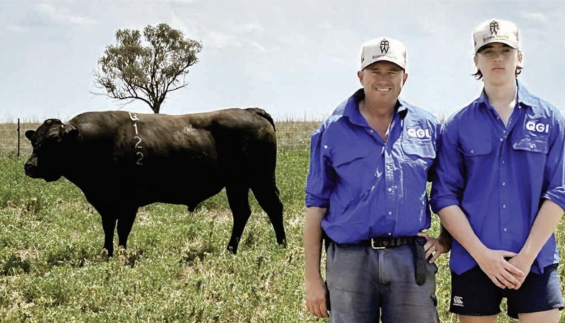
Figure 2: Peter and Alex Bishop with Q122 in the paddock in 2023.
Q122 was purchased by the AWA Membership Quality Genetics International (QGI). The QGI team said:
“It’s a rare occurrence when all the ducks line up to acquire the right Bull. As well as being well balanced with EBV’s, the animal was extraordinarily sound and in excellent condition. The phenotype correlated well with the data that was predicted at the time of purchase. QGI also prefer to purchase sires free from all know genetic recessive diseases. The Bulls are also required to pass all protocols for entry into a collection facility, prior to exporting semen.”
The QGI team was approached by herds in the USA (2) and in Australia (2) to conducted progeny test programs on QGI bulls. In Australia, Bishop Wagyu (PCP) AI’d 220 content registered F1 females to 3 Sires including a link sire. These females were also backed up to Bishop Wagyu Sires. All progeny were kept in cohorts their entire life until slaughter, both live phenotype and carcase traits were recorded (including digital carcase imaging) and submitted to BREEDPLAN. Q122 is also a link sire in the 1st and 2nd cohorts of the AWA-PTP, the progeny of cohort 1 to be processed and submitted for analysis soon, further improving the accuracies of Q122’s EBV’s.
Having semen available for sale within 2020, QGI developed relationships with leading producers and marketers of Wagyu genetics in Europe, South Africa, South America and the USA. Q122 now has 580 registered progeny in more than 40 different AWA member herds from The Republic of Ireland, through Europe, the UK, Philippines, the USA and Australia.
The first progeny of Q122 that hit the ground were born in May 2021, with slaughter progeny born in August 2021. Prior to the November (run 2) 2023 BREEDPLAN analysis, carcase data which included 52 slaughter progeny of Q122, along with a number of progeny from other sires was submitted to the AWA. This data enabled the comparison of Q122’s original EBV’s, to those prior to and following carcase data submission.
Figure 3 shows the change in Carcase Trait EBVs for Q122 over the period from his advertisement in the April 2020 Elite Wagyu Sale (timeline point 1), through to the most recent BREEDPLAN run (December 2023 run 1; timeline point 4). Key dates of note also highlighted at the timeline on the bottom of the graph are the point where new genetic parameters for the Wagyu BREEDPLAN analysis were introduced in April 22 (timeline point 2) and the November 2023 BREEDPLAN run directly prior to the carcase data submission (timeline point 3).
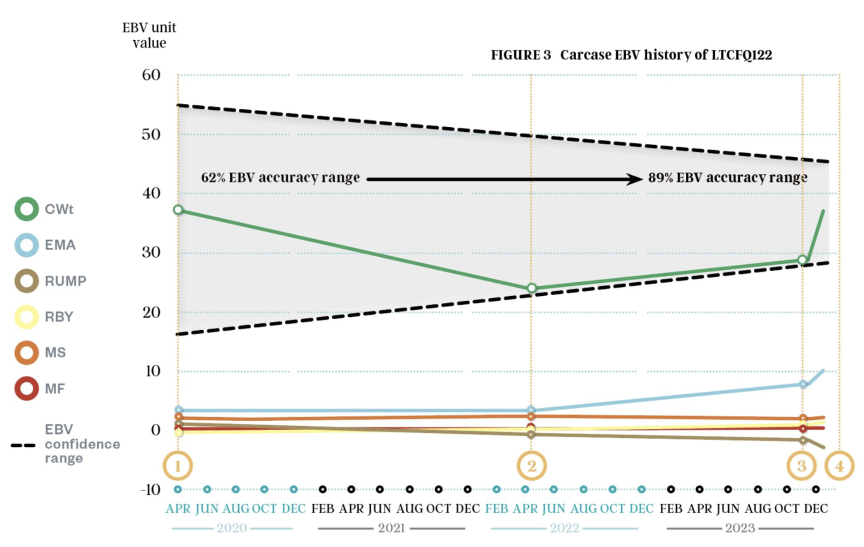
Figure 3: Carcase EBV History Of LTCFQ122
Looking at the CWT (Carcase Weight) EBV change in Figure 3, the EBV Confidence Range (black dashed line and shadowed area) has been added to show the possible change in the CWT EBV in April 2020 (62% accuracy) through to December 2023 (89% accuracy). The CWT EBV for Q122 changed significantly with the implementation of new genetic parameters in the BREEDPLAN model in April 2022. With addition of data from other sires linked to Q122 and with increasing growth data from Q122 progeny over the period to November 2023, Q122’s CWT EBV increased. With subsequent addition of carcase data on slaughter progeny prior to the December 2023 BREEDPLAN run, Q122’s CWT EBV increased further from +29 to + 37.
The Confidence Range window provided in Figure 3 for the CWT EBV of Q122 is a graphical representation of the possible change which could be expected in the CWT EBV at different levels of EBV accuracy. This concept was covered in Wagyu Update Volume 83 pp 18-20. As the accuracy of Q122’s CWT EBV increases, the expected magnitude of change in Q122’s CWT EBV reduces significantly. It should be noted from Figure 3, that even after the December 2023 analysis with a relatively high CWT of +37 and high EBV accuracy of 89%, we can still expect that Q122’s CWT EBV may change within a range of ±7.5 from approximately +45 to +29.
Also shown in Figure 3 is the change in the MS EBV of Q122 (orange line). Although the scale of the Y axis does not allow for good visual analysis of change in the MS EBV of Q122, his initial predicted MS EBV in April 2020 was 1.8 (59% accuracy and Confidence Range of ± 0.9 MS units), with his December 2023 EBV after 52 carcase records being 2.2. (89% accuracy and Confidence Range of ± 0.5 MS units).
Significantly more change was observed in the EMA trait for Q122, with his initial predicted EMA EBV in April 2020 being 3.3 (56% accuracy and Confidence Range of ± 4.9 EMA units), and his December 2023 EBV after 52 carcase records being 10.1 (86% accuracy and Confidence Range of ± 2.9 EMA units). Q122’s EMA EBV actually increased outside the original expected Confidence Range, indicating that Q122’s performance for EMA was statistically extreme.
The Confidence Range for any EBV for any registered animal can be found by clicking on the “View” link next to the “EBV Graph” item on the Animal Details list directly above the pedigree information for any AWA registered animal. Two graphs can be displayed. You can switch between the graphs to get the below EBV Graph by clicking the “Switch Graph” button.
The centre of the EBV Graph for each trait shown for Q122 is the Breed Average for the trait. Looking at the CWT trait, the CWT EBV for Q122 is heavier than Breed Average with a narrow Confidence Range. Likewise, for the MS trait, the MS EBV is higher than Breed Average with a narrow Confidence Range. The actual EBVs for each trait are shown in the EBV table below the EBV graph. The “Traits Analysed” line indicates which traits were recorded on Q122 himself and “Statistics” line shows that data from 33 of the 40 herds recorded with Q122 progeny registered have submitted data to the AWA and the number of Q122’s progeny that have phenotypic data recorded with the AWA is 360 (out of 580 total registered progeny). The number of slaughter progeny with carcase data submitted (52) is also listed.
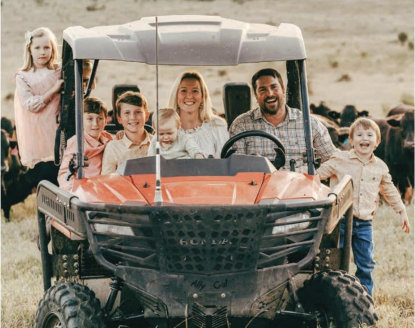
The Hewitt Family purchased ADBFL0010 Mayura L0010 (L0010) at the 2017 Elite Wagyu Sale.
ADBFL0010 Mayura L0010
Our second test case is the ADBFA0139 sired ADBFL0010 Mayura L0010 (L0010). Born in 2015, this bull was registered with the AWA in February 2017 with genomics being recorded prior to the April 2019 BREEDPLAN run. This bull was purchased by Hewitt Pastoral Enterprises (HPE) at the 2017 Elite Wagyu Sale where he was in the top 1% of the breed for Marbling and Selection Indexes.
With semen commercially available in 2018. The first progeny of L0010 were registered from May 2018 within the HPE herd, with early international progeny noted in the USA (Ranger Cattle Company: RGR) in 2019. L0010 is arguably the first of the new genomic super sires to be used globally, with 1,434 progeny now recorded in more than 130 different member herds around the world.
In the Wagyu Quarterly Volume 83 pp 45-49, we noted that L0010 was the 28th ranked sire by total progeny numbers at that time, with approximately 950 progeny recorded with the AWA in late 2022. Within the last 12 months, a further 484 progeny by L0010 have been registered. This would now make L0010 the 16th ranked bull by total progeny numbers recorded with the AWA from 1994 – 2023.
Cameron Hewittt said:
“We have been very happy with L0010’s figures. As the data was put in and his EBV accuracy grew, L0010 stayed fairly strong in most traits as his accuracy went up. Although he only has 1,434 registered progeny he actually has thousands more that we and a few others breeders have that are in commercial crossbred progeny test herds. L0010 was the first progeny of Jnr sold by Mayura Station. We focused on implementing his genetics into our herd and a while later we realised there was international interest and we decided to offer his semen abroad while keeping him off the open market in Australia for many years”.
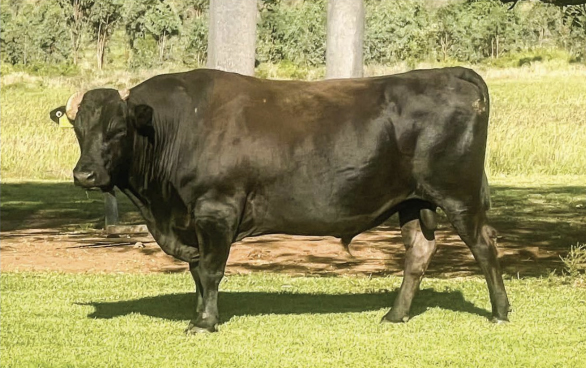
Figure 4: ADBFL0010 Mayura L0010
“His Angus F1’s recently won the most valuable pen at the Ekka Wagyu paddock to palate competition. If we had understood more in the early days about what the requirements were for a contemporary group to be effective in BREEDPLAN, we would have had more crossbred carcase data in. Our first eligible crossbred contemporary group which includes L0010 progeny is due to have the carcass data back around March next year which we are excited about. His steers are topping harvests in many operations in the US and here.
Looking at L0010’s carcase EBV history since his genomics were recorded (Figure 5), we can see that his original CWT EBV in April 2019 was +29kg (timeline point 1). The EBV Confidence Range (black dashed line) shows the possible expected change in the CWT EBV in April 2019 (64% accuracy) through to December 2023 (89% accuracy). The CWT EBV for L0010 changed significantly in April 2020 (timeline point 2), with early progeny starting to be recorded for growth traits that indicated the CWT EBV estimated prior to progeny records was lower than predicted following addition of progeny records for growth traits.
With the implementation of new genetic parameters in the BREEDPLAN model in April 2022 and with submission of growth data for an additional 100 early L0010 progeny, the CWT EBV for L0010 increased to +40 (timeline point 3). With subsequent addition of carcase data on 16 slaughter progeny prior to the April 2023 BREEDPLAN run (timeline point 4), L0010’s CWT EBV increased further to +45. In the most recent (December 2023; timeline point 5) BREEDPLAN, an additional 11 carcase progeny have been recorded, taking the total carcase progeny records for L0010 to 27. His CWT EBV reduced slightly to +37 with an accuracy of 89%.
Zooming in on the other carcase trait EBVs reported for L0010, we can see an expansion of the bottom portion of Figure 5, which is shown in Figure 6. Looking at the red line which shows L0010’s Marble Score EBV history across the key timeline points, we observe that the original genomic predicted EBV in April 2019 for L0010 was +1.7 at an accuracy of 63%. At this accuracy level, the EBV Confidence Range was ± 0.9 MS units. In comparison to the change in the CWT EBV accuracy (increase of 25% accuracy), the MS EBV of L0010 only increased in accuracy by 13% to 76% accuracy by December 2023.
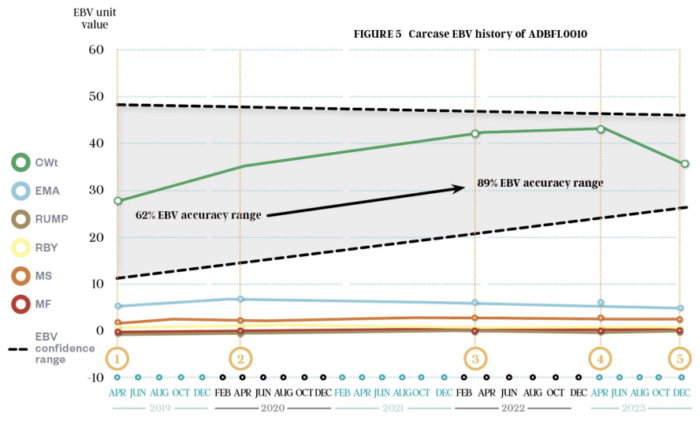
Figure 5. Carcase EBV history of ADBFL0010
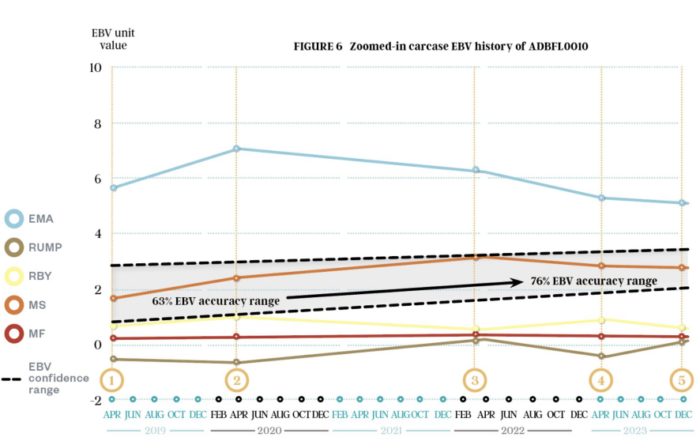
Figure 6: Zoomed in carcase EBV history of ADBFL0010
The change in accuracy level for the Marble Score EBV is lower compared to the Carcase Weight EBV because there is less correlated trait data to inform the Marble Score EBV. Changes in the Carcase Weight EBV accuracy is helped by liveweight records on progeny, particularly 400 and 600 day weight records.
The Marble Score EBV for L0010 shows some change across the timeline from April 2019 through to December 2023. However, the Marble Score EBV stays within the EBV Confidence Range through to its current EBV value of +2.8.
Similar to LTCFQ122, we see larger variation in the Eye Muscle Area trait EBV over the timeline shown in Figure 5. This is partly due to the broader range of EBVs for Eye Muscle Area (± 4.4 EMA units) units at lower accuracy (60% in 2019). The EBV Confidence Range for L0010’s EMA EBV of +5.7 in April 2019 would be +1.3 to +10.1. His EMA EBV in December 2023 was +5.1.
Looking at the EBV Graph for L0010, again, each trait shown for L0010 is plotted relative to the Breed Average for the trait. Looking at the CWT trait, the CWT EBV for L0010 is heavier than Breed Average with a narrow Confidence Range. Likewise, for the MS trait, the MS EBV is higher than Breed Average, but with a broader Confidence Range due to its lower accuracy compared to Q122. The statistics line shows that although L0010 has progeny registered in more than 130 herds, 94 of these have progeny with data submitted, with trait data on 805 progeny used to inform L0010’s EBVs, including 27 slaughter progeny with carcase data submitted.
Summary
This article compared early SingleStep (including genomics) carcase EBVs for two third-generation bulls that have been used widely around the world based on their EBV values. Looking at the EBVs for both sires over time, we can see that the addition of phenotype data from the progeny of sires produces significant change in EBV’s. These changes in EBVs are the result of improved EBV calculation, which uses the sires existing pedigree, own performance records and genomic data, along with the addition of phenotypic records on progeny of the sire to improve the estimated genetic merit of the sires and their relatives.
As data for progeny of a sire becomes recorded with the AWA, the improved EBV calculation will be reflected not only in the change in the EBV itself, but also an increase in the accuracy of the EBV for which progeny data is used.
As a sire’s EBV calculation improves (and accuracy increases), it is important to note that the Confidence Range (possible change) in the EBV will narrow, but the EBV could still change within that Confidence Range. As such, using EBVs to select lower accuracy sires can be a good guide to selecting potentially high performing young sires in your herd. But it is important to note that the EBV value for any trait is likely to change within the Confidence Range.
Higher accuracy animals will have more data recorded on their own performance and their progeny and they will have narrower Confidence Range intervals within which we would expect EBVs to change. This makes using higher accuracy sires more reliable within breeding programs because the predicted response in the next generation can be more accurately estimated.
This article is property of the Australian Wagyu Association, you must seek approval before republishing.
Media Contact: Emily Rabone (AWA Communications Manager), 0437 388 481 or [email protected]
